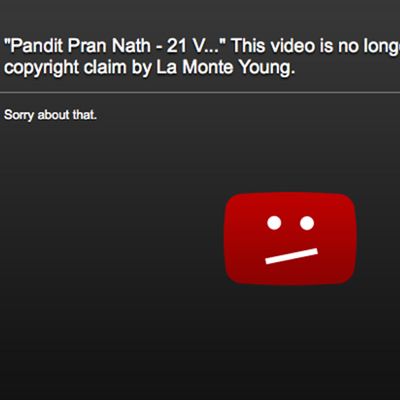
Experimental music still constitutes only a speck of music sales, streams, and performances, but itÔÇÖs never been bigger or easier to find. You can choose between a┬áfive-CD┬áSteve Reich boxed set┬áor a┬áten-CD┬áSteve Reich boxed set. Maybe youÔÇÖd prefer a┬ádozen discs of Pauline Oliveros. Even less-celebrated experimentalists, such as Laurie Spiegel, are not only being┬áreissued┬ábut┬áwell received. YouÔÇÖd have to be a pretty minor Minimalist not to have even one record in print. Either that or a genius, pioneering control-freak who spends years preparing each release, like La Monte Young, featured in this weekÔÇÖs issue of New York.┬á
A near-mint copy of YoungÔÇÖs┬áThe Well-Tuned Piano┬ásold on eBay last month for┬ámore than $400. (I have a vinyl copy. Offer $350 and itÔÇÖs yours.) He hasnÔÇÖt released many records, and the ones he has released are out of print. If you want to hear his music, youÔÇÖll need to put on your wading boots. Even then it might be difficult because Young doesnÔÇÖt hesitate to file┬áDMCA takedown notices, forcing music to be removed from websites. By the time you click on these links, some might already be gone.
Unfortunately, we could find no performance of Composition 1960 #2, which instructs the performer to ÔÇ£build a fire in front of the audience,ÔÇØ or ÔÇ£Piano Piece for Terry Riley #1,ÔÇØ which reads:
Push the piano up to a wall and put the flat side flush against it. Then continue pushing into the wall. Push as hard as you can. If the piano goes through the wall, keep pushing in the same direction regardless of new obstacles and continue to push as hard as you can whether the piano is stopped against an obstacle or moving. The piece is over when you are too exhausted to push any longer. 
One of YoungÔÇÖs most accessible pieces ÔÇö and one of the few heÔÇÖs ever recorded ÔÇö is Dream House 78ÔÇÖ 17ÔÇØ, two separate drone pieces released on vinyl by the French label Shandar in 1974 and never reissued. You can buy a copy on Amazon for only $598 (plus $3.99 shipping). It features future Talking Heads collaborator Jon Hassell on trumpet.
On YouTube, there are numerous links for the Gramavision version of The Well-Tuned Piano (recorded in ÔÇÖ81, released in ÔÇÖ87), usually split into one-hour excerpts. Helpfully, the San FranciscoÔÇôbased Radio Valencia has a podcast┬áwhere you can stream or download continuous audio from The Well-Tuned Piano in the Magenta Lights, a 1987 performance running six and a half hours, released by Young as a DVD on his own Just Dreams label in small quantities (536 copies), priced at $146, and now out of print. Being able to download the audio is great, even if a flight from New York to San Francisco isnÔÇÖt long enough to hear the whole thing.
ÔÇ£Trio for StringsÔÇØ is the foundational piece of Minimalism. Young, who wrote it in 1958, told me: ÔÇ£The entire work is pretty much made up of sustained tones. ThereÔÇÖs an occasional short tone, and it comes as a pulse, like a cricket in the night or the special hoot of an owl. Today, because so many people have gone on to work with drones and other sustained tones, it doesnÔÇÖt seem so astonishing. At the time I did it, there was absolutely no precedent for it in the history of music.ÔÇØ Nonetheless, one commenter on rateyourmusic.com calls it ÔÇ£sub-par serial string drones with unimpressive use of silence.ÔÇØ
Here is YoungÔÇÖs late guru, Pandit Pran Nath, a master of the kirana style of Indian classical vocal music, which dates to the 13th century and involves tiny gradations of pitch.
For as long as it lasts, hereÔÇÖs a download of his out-of-print albums, plus a lot of other stuff that isnÔÇÖt identified or tagged, from a file-sharing site. ItÔÇÖs more than 24 hours of Young. ÔÇ£A lot of my music is online already,ÔÇØ he told Vulture. ÔÇ£People can put things out fast and dirty, and to some degree, the world is satisfied with that.ÔÇØ HeÔÇÖs not among them. ÔÇ£WeÔÇÖre not interested in putting out junk, weÔÇÖre interested in perfection. It takes time to put out masterpieces.ÔÇØ
The score for YoungÔÇÖs ÔÇ£Composition 1960 #7ÔÇØ consists of two notes, a B and an F-sharp, with the instruction: ÔÇ£To be held for a long time.ÔÇØ When it was performed by a violinist, a violist, and a cellist at Judson Hall in 1962, Howard Klein of the New York Times sneered that the 48-minute piece was ÔÇ£witlessÔÇØ and derided ÔÇ£the dreary affectation of the evening.ÔÇØ HereÔÇÖs a shorter recent performance, with two distorted guitars.
The hideous, impaling screech of YoungÔÇÖs ÔÇ£2 SoundsÔÇØ (1960), which Young calls ÔÇ£Friction Noise Music.ÔÇØ One sound is made by scraping a tin can against a pane of glass; the second is made by abrading a gong with a drumstick. ÔÇ£When the first sound starts, you cannot imagine that any more horrible sound exists in the whole world,ÔÇØ Cornelius Cardew wrote. ÔÇ£Then the second comes in and you have to admit you were wrong.ÔÇØ Nonetheless, both Simone Forti and Merce Cunningham choreographed dances to it.
In ÔÇ£Poem for Chairs, Tables, Benches, Etc.ÔÇØ (1960), performers drag and shove furniture along a hard floor. ÔÇ£The sound was magnificent,ÔÇØ John Cage kvelled after he performed in its New York premiere. Performances have been as brief as five seconds and as long as 50 hours.
And also:
Lastly, here are some similar noises being made by puppies.

